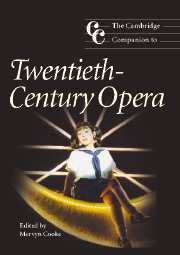Book contents
- Frontmatter
- Part one Legacies
- Part two Trends
- Part three Topographies
- Part four Directions
- 14 Music theatre since the 1960s
- 15 Minimalist opera
- 16 Opera and film
- 17 Popular musical theatre (and film)
- 18 Opera in the marketplace
- 19 Technology and interpretation: aspects of ‘modernism’
- Works cited
- General index
- Index of operas
19 - Technology and interpretation: aspects of ‘modernism’
from Part four - Directions
Published online by Cambridge University Press: 28 September 2011
- Frontmatter
- Part one Legacies
- Part two Trends
- Part three Topographies
- Part four Directions
- 14 Music theatre since the 1960s
- 15 Minimalist opera
- 16 Opera and film
- 17 Popular musical theatre (and film)
- 18 Opera in the marketplace
- 19 Technology and interpretation: aspects of ‘modernism’
- Works cited
- General index
- Index of operas
Summary
In the course of the twentieth century, various technological advances had as radical an effect on the art of opera as the changes associated with ‘modernism’ had on the character of musical composition. Opera at the start of the twenty-first century has become at the same time both more popular and, in a particular but important sense, less popular. The music of the operas of the past is more familiar to the public than ever before – thanks to the invention and refinement of broadcasting and mechanical recording, both aural and visual. The words of operas are better understood by opera-goers than they have ever been, thanks to the introduction during the 1990s of surtitles or supertitles providing simultaneous versions of the text in opera-house auditoria.
Meanwhile, the taste of the public for classical music seems to have been growing ever more retrogressive. In an era when so-called ‘serious’ music broke away from the familiarly melodious and became far more theoretical and experimental, the popularity of new music steadily reduced and music lovers grew less and less amenable to genuine innovation, though new forms of lyrical expression in jazz and rock singing may offer qualification for this verdict. In colour, rhythm and harmony, modern orchestral music has tended to be far more adventurous, and the vocal lines of opera far more unpredictable, than ever before.
- Type
- Chapter
- Information
- The Cambridge Companion to Twentieth-Century Opera , pp. 321 - 340Publisher: Cambridge University PressPrint publication year: 2005
- 1
- Cited by

